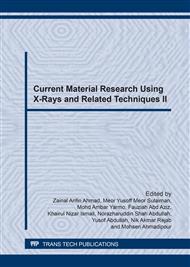[1]
H. Arakawa, A. T. Bell, Effects of potassium promotion on the activity and selectivity of iron Fischer–Tropsch catalysts, Ind. Eng. Chem. Proc. Des. Dev. 22 (1) (1983) 97–103.
DOI: 10.1021/i200020a017
Google Scholar
[2]
D. B. Bukur, K. Okabe, M. P. Rosynek, C. Li, D. Wang, K. R. P. M. Rao, Activation studies with a precipitated iron catalyst for Fischer–Tropsch synthesis I characterization studies. J. Catal. 155(2) (1995) 353–65.
DOI: 10.1006/jcat.1995.1217
Google Scholar
[3]
D.B. Bukur, L. Nowicki, R.K. Manne, X. Lang, Activation studies with a precipitated iron catalyst for Fischer–Tropsch synthesis II reaction studies, J. Catal. 155(2) (1995) 366–75.
DOI: 10.1006/jcat.1995.1218
Google Scholar
[4]
M.D. Shroff, D.S. Kalallad, K.E. Coulter, S.D. Kohler, M.S. Harrington, N.B. Jackson, Activation of precipitated iron Fischer–Tropsch synthesis catalysts, J. Catal. 156(2) (1995) 185–207.
DOI: 10.1006/jcat.1995.1247
Google Scholar
[5]
J.P. Baltrus, J.R. Diehl, M.A. McDonald, M.F. Zarochak, Effects of pretreatment on the surface properties of iron Fischer–Tropsch catalysts, App. of Catal. 48(1) (1989) 199–213.
DOI: 10.1016/s0166-9834(00)80276-6
Google Scholar
[6]
M. Luo, B.H. Davis, Fischer–Tropsch synthesis: activation of low-alpha potassium promoted iron catalysts, Fuel Proc Tech. 83(1–3) (2003) 49–65.
DOI: 10.1016/s0378-3820(03)00077-8
Google Scholar
[7]
G. Bian, A. Oonuki, N. Koizumi, H. Nomoto, M. Yamada, Studies with a precipitated iron Fischer–Tropsch catalyst reduced by H2 or CO, J. Mol. Catal. A. 186(1–2) (2002) 203–13.
DOI: 10.1016/s1381-1169(02)00186-3
Google Scholar
[8]
R.J. O'Brien, L. Xu, R.L. Spicer, S. Bao, D.R. Milburn, B.H. Davis, Activity and selectivity of precipitated iron Fischer–Tropsch catalysts, Catal. Today. 36(3) (1997) 325–34.
DOI: 10.1016/s0920-5861(96)00246-5
Google Scholar
[9]
J.J. Venter, M.A. Vannice, Olefin selective carbon-supported K–Fe–Mn CO hydrogenation catalysts: A kinetic, calorimentric, chemisoption, infrared and mössbaure spectroscopic investigation, Catal. Lett. 7(1–4) (1990) 219–40.
DOI: 10.1007/bf00764505
Google Scholar
[10]
G.B. Raupp, W.N. Delgass, Mössbauer investigation of supported Fe catalysts III. In situ kinetics and spectroscopy during Fischer–Tropsch synthesis, J. Catal. 58(3) (1979) 361–9.
DOI: 10.1016/0021-9517(79)90275-6
Google Scholar
[11]
G.B. Raupp, W.N. Delgass, Mössbauer investigation of supported Fe and FeNi catalysts II carbides formed by Fischer–Tropsch synthesis, J. Catal. 58(3) (1979) 348–60.
DOI: 10.1016/0021-9517(79)90274-4
Google Scholar
[12]
T. Herranz, S. Rojas, F.J. Pérez-Alonso, M. Ojeda, P. Terreros, J.L.G. Fierro, Genesis of iron carbides and their role in the synthesis of hydrocarbons from synthesis gas, J. Catal. 243(1) (2006) 199–211.
DOI: 10.1016/j.jcat.2006.07.012
Google Scholar
[13]
D.J. Young, Carburization and metal dusting, in: Shreir's corrosion, Elsevier, Australia, 2010, p.272–303.
Google Scholar
[14]
P.L. Walker Jr., F. Rusinko Jr., L.G. Austin, Gas reactions of carbon. In advances in catalysis, Academic Press. 11 (1959) 133−221.
DOI: 10.1016/s0360-0564(08)60418-6
Google Scholar
[15]
T. Herranz, S. Rojas, F.J. Pérez-Alonso, M. Ojeda, P. Terreros, J.L.G. Fierro, Genesis of iron carbides and their role in the synthesis of hydrocarbons from synthesis gas, J. Catal. 243(1) (2006) 199–211.
DOI: 10.1016/j.jcat.2006.07.012
Google Scholar
[16]
H. Hwang, U. Chung, W. Chung, Y. Cho, B. Jung, G.P. Martin., Carburization of iron using CO-H2 gas mixture, Met. And Mater. Inter. 10(1) (2004) 77–82.
DOI: 10.1007/bf03027366
Google Scholar


